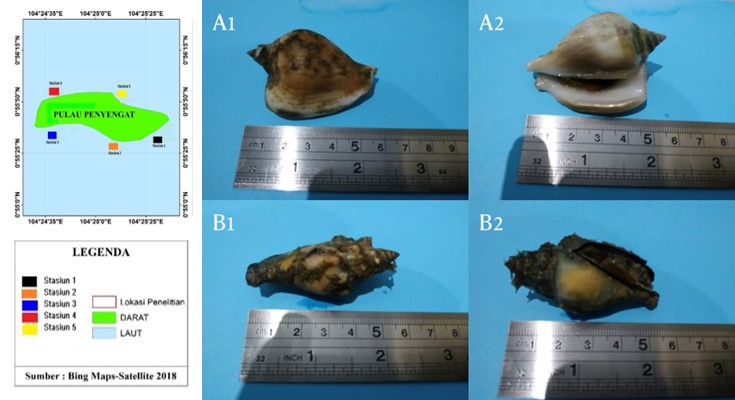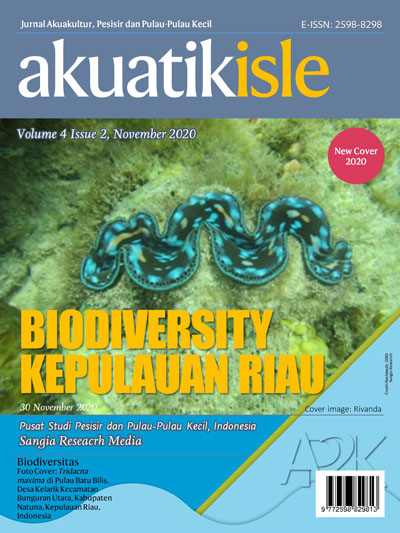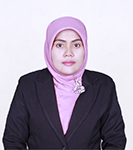Akuatikisle: Jurnal Akuakultur, Pesisir dan Pulau-Pulau Kecil
Full Length Article
Conditions and pattern of utilization of gonggong snails in Penyengat Island waters, Tanjungpinang Kota District, Riau Islands, Indonesia
Kondisi dan pola pemanfaatan siput gonggong di Perairan Pulau Penyengat Kecamatan Tanjungpinang Kota, Kepulauan Riau, Indonesia
Highlights
Generate NLP AI by Wizdam ID.
Abstract
This study aims to determine the conditions and patterns of utilization of snails in the Penyengat island waters, Riau Island, Indonesia. The method used was purposive sampling of 5 stations with 70 x 2 m quadratic transect for the density of the Gonggong Snail. The results found two types of snail bark species namely Laevistrombus turturella and Strombus urceus with a total density value of 0.114individual per m². The use of snail bark patterns in Penyengat Island waters, namely the size of the catch is medium to large, manual capture techniques (collected by hand), the catching area in the waters of the island is 100-200 m from the beach, the most catches found >100 individuals, season and time of catching snail barks at stinging island waters are not based on season, utilization and distribution of utilization. The snail bark resource is used for consumption and sold to collectors.
Abstract
Penelitian bertujuan untuk mengetahui kondisi dan pola pemanfaatan siput gonggong di perairan Pulau Penyengat, Kepulauan Riau, Indonesia. Metode sampling yang digunakan adalah purposive sampling sebanyak pada 5 stasiun dengan transek kuadrat berukuran 70 x 2 m untuk kepadatan Siput Gonggong. Hasil penelitian ditemukan dua jenis siput gonggong spesies yaitu Laevistrombus turturella dan Strombus urceus dengan nilai total kepadatan sebesar 0,114 individu per m². Pola pemanfaatan siput gonggong di Perairan Pulau Penyengat yaitu ukuran tangkap yaitu ukuran sedang hingga besar, teknik penangkapan dengan cara manual (dipungut menggunakan tangan), area penangkapan di perairan Pulau Penyengat yaitu 100-200 m dari pantai, jumlah tangkapan yang paling banyak didapati >100 individu. Waktu penangkapan siput gonggong diperairan pulau penyengat tidak berdasarkan musim, pemanfaatan, dan distribusi pemanfaatan. Sumberdaya siput gonggong dimanfaatkan untuk konsumsi dan dijual ke pengepul.
Keywords
Introduction
Section snippets
Material and Methods
Materials and methods from the full-text PDF of this article cannot be displayed.
Results
Results from the full-text PDF of this article cannot be displayed.
Discussion
Discussion from the full-text PDF of this article cannot be displayed.
Conclusions
Conclusions from the full-text PDF of this article cannot be displayed.
Acknowledgment
Acknowledgment from the full-text PDF of this article cannot be displayed.
Competing interest
The authors declare that they have no known competing financial interests or personal relationships that could have appeared to influence the work reported in this paper.
Conflict of interest
The authors declare that the research was conducted in the absence of any commercial or financial relationships that could be construed as a potential conflict of interest.
Ethical approval acknowledgements
No ethical approval required for this article. All procedures followed were in accordance with the ethical standards of the responsible committee on human experimentation (institutional and national) and with the Helsinki Declaration of 1975, as revised in 2008 (5)
Supplementary files
Data sharing not applicable to this article as no datasets were generated or analysed during the current study, and/or contains supplementary material, which is available to authorized users.
References (1)
Brower, J. E., Zar, J. H., & Von Ende, C. N. 1990. Field and Laboratory Methods for General Ecology. Brown Company Publishers. Ohio.
Chim, C.K., M.L. Neo, & K.S. Loh, 2009. The status in Singapore of Strombus (Dolomena) Marginatus sowerbyorum Visser & Man In’t Veld, 2005 (Mollusca: Gastropoda: Strombidae). Nature in Singapore, 2:379–384.
Cob, Z.C., A. Arshad, J.S. Bujang, & M.A. Ghaffar, 2014. Spatial and temporal variations in Strombus canarium (Gastropoda: Strombidae) abundance at Merambong Seagrass Bed, Malaysia. Sains Malaysiana, 43(4): 503–511.
Dini, D. R., Susiana, S., & Suryanti, A. 2020. Eating habits of sea cucumber (Holothuria scabra) and sea cucumber sap (Holothuria vagabunda) in Karas waters, Batam City, Indonesia. Akuatikisle: Jurnal Akuakultur, Pesisir dan Pulau-Pulau Kecil, 4(1), 13-19. https://doi.org/10.29239/j.akuatikisle.4.1.13-19.
Dody, S. 2012. Pemijahan dan Pengembangan Larva Siput Gonggong (Strombus turturella) di Kepulauan Bangka Belitung. Jurnal Ilmu dan Teknologi Kelautan Tropis. 4(1): 107-113.
Irawan, H. 2015. Studi Identifikasi Siput Gonggong Di Zona Litoral Pesisir Timur Pulau Bintan. Dinamika Maritim, 5(1), 38–45.
Linarwati, M., Fathoni, A., & Minarsih, M. M. 2016. Studi deskriptif pelatihan dan pengembangan sumberdaya manusia serta penggunaan metode behavioral event interview dalam merekrut karyawan baru di bank mega cabang kudus. Journal of Management, 2(2).
Marni, R., Lestari, F., & Susiana, S. 2020. Ecological potential and spread distribution pattern sea cucumber Holothuria scabra and Holothuria vagabunda at Tanjungkeramat waters in Pangkil Village Bintan Regency, Indonesia. Akuatikisle: Jurnal Akuakultur, Pesisir dan Pulau-Pulau Kecil, 4(1), 7-11. https://doi.org/10.29239/j.akuatikisle.4.1.7-11.
Muzahar. 2017. Perbandingan Fenotipe dan Analisis Genotipe Lima Varian Siput Gonggong (Dog conch, Laevistrombus sp.) dari Madong-Tanjungpinang Sebagai Dasar Pemilihan Spesies Budidaya. Biofalux. 14(4): 1164-1172.
Muzahar, & A.A. Hakim, 2018. Spawning and development of dog conch Strombus sp. larvae in the laboratory. Jurnal Ilmu dan Teknologi Kelautan Tropis, 10(1): 209–216. http://doi.org/10.29244/jitkt.v10i1.18 607
Riniatsih, I., & Kushartono, E. W. 2009. Substrat Dasar dan Parameter Oseanografi Sebagai Penentu Keberadaan Gastropoda dan Bivalvia di Pantai Sluke Kabupaten Rembang. ILMU KELAUTAN: Indonesian Journal of Marine Sciences, 14(1), 50–59. https://doi.org/10.14710/ik.ijms.14.1.50-59
Rochmady, R., Omar, S.B., & Tandipayuk, L.S, 2011. Analisis perbandingan pertumbuhan populasi kerang lumpur (Anodontia edentula, Linnaeus 1758) di perairan kepulauan Tobea dan pesisir Lambiku, Kecamatan Napabalano, Kabupaten Muna. Agrikan: Jurnal Agribisnis Perikanan, 4(2): 15-21. https://doi.org/10.29239/j.agrikan.4.2.15-21
Rochmady, R., Omar, S.B., & Tandipayuk, L.S, 2012. Nisbah kelamin dan ukuran pertama matang gonad kerang lumpur Anodontia edentula, Linnaeus 1758 di pulau Tobea, Kecamatan Napabalano, Kabupaten Muna. Agrikan: Jurnal Agribisnis Perikanan 5(2): 25-32. https://doi.org/10.29239/j.agrikan.5.2.25-32
Rochmady, R., S.B.A. Omar, & L.S. Tandipayuk. 2016. Density of mudclams Anodontia edentula Linnaeus, 1758 relation to enviromental parameters of Muna Regency. Simposium Nasional Kelautan dan Perikanan, 3(2016): 149-159.
Rosady, V.P., Astuty, S., & Prihadi, D.J. 2016. Kelimpahan dan Kondisi Habitat Siput Gonggong (Strombus turturella) di Pesisir Kabupaten Bintan Kepulauan Riau. Perikanan Kelautan. 7(2): 35-44.
Siddik, J. 2011. Sebaran Spasial dan Potensi Reproduksi Populasi Siput Gonggong (Strombus turturella) di Teluk Klabat Bangka-Belitung. [Skripsi]. Institut Pertanian Bogor. Bogor.
Siringoringo, R, M., Satria, R., Abrar, M., Hermanto, B., Wibowo, K., Arbi, U., Mudjiono, Eka, W., Rahmawati, & S., Sutiadi, R. 2014. Monitoring Kesehatan Terumbu Karang dan Kesehatan Ekosistem Terkait di Kabupaten Kepulauan Mentawai, Jakarta. COREMAP CTI LIPI. 43 pp.
Susiana, S., A. Apriandi, & Rochmady, R. 2019. Identifikasi Jenis Kelamin Siput Gonggong Strombus sp. Secara Morfologi di Perairan Madung, Tanjungpinang, Indonesia. Jurnal Ilmu dan Teknologi Kelautan Tropis, 11(3): 555-567.
Susiana, S. 2011. Diversitas dan Kerapatan Mangrove, Gastropoda dan Bivalvia di Estuari Perancak, Bali. [Skripsi]. Universitas Hasanuddin. Makassar.
Susiana, S., Niartiningsih, A., Amran, M. A., & Rochmady, R. 2017. Suitability of location for restocking clams Tridacnidae in the Spermonde Archipelago. Jurnal Ilmu dan Teknologi Kelautan Tropis, 9(2): 475-490. https://doi.org/10.29244/jitkt.v9i2.19284
Soeharmoko. 2010. Inventarisasi Jenis Kekerangan yang di Konsumsi Masyarakat di Kepulauan Riau. Dinamika Maritim. 2(1): 45-52.
Syukri, M. 2018. Potensi Dan Pola Pemanfaatan Siput Gonggong di Perairan Pulau Kapal Desa Tembeling Kecamatan Teluk Bintan Kabupaten Bintan. [Skripsi]. Universitas Maritim Raja Ali Haji: Tanjungpinang.
Viruly, L., Nuri, A., Maggy, T.S., & Mala, N. 2019. Protein Histon Pada Siput Gonggong Bintan Strombus sp. Sebagai Kandidat Pangan Fungsional. Jurnal Ilmu dan Teknologi Tropis. 11(1): 89-101.
Yanti. 2016. Keanekaragaman Jenis Siput Gonggong di Perairan Desa Pangkil Kecamatan Teluk Bintan Kabupaten Bintan. [Tesis]. Universitas Maritim Raja Ali Haji. Kepulauan Riau.
Bibliographic Information
Cite this article as:
-
Submitted
13 January 2020 -
Revised
22 May 2020 -
Accepted
10 June 2020 -
Published
17 October 2020 -
Version of record
24 October 2020 -
Issue date
30 November 2020
-
Academic subject
Fisheries; Fisheries Science
Copyright
Sangia Advertisement
Kepulauan Riau has enormous potential for marine resources. Marine biological resources ranging from mangroves, fish, shellfish, coral, and much more. However, behind such great wealth, there are also management challenges. Susiana and colleagues inventory potential resources of Tridacnidae clams in Riau Islands, Indonesia. See Rivanda et al.
Copyright © 2020 Raja Wira Pradana, Febrianti Lestari, & Susiana Susiana. Sangia Research Media and Publishing. Production and hosting by Sangia (SRM™).  This work is licensed under a Creative Commons Attribution-ShareAlike 4.0 International License.
This work is licensed under a Creative Commons Attribution-ShareAlike 4.0 International License.
Disclaimer: All claims expressed in this article are solely those of the authors and do not necessarily represent those of their affiliated organizations, or those of the publisher, the editors and the reviewers. Any product that may be evaluated in this article or claim that may be made by its manufacturer is not guaranteed or endorsed by the publisher.
Comments on this article
By submitting a comment you agree to abide by our Terms and Community Guidelines. If you find something abusive or that does not comply with our terms or guidelines please flag it as inappropriate.










